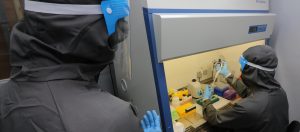
Do you know that the biorisk policy in the country actually took root in UPLB?
This is well documented and was pointed out several times by Dr. Gianne Eduard L. Ulanday, research faculty member and certified biosafety officer of the National Training Center for Biosafety and Biosecurity at the National Institutes of Health in UP Manila who spoke at an online seminar on biosafety and biosecurity for UPLB biosafety officers and researchers.
“UPLB played a vital role in the biosafety framework that we are using (in the country) now. UPLB is at the forefront of biotechnology and always has the latest in biotech techniques,” Dr. Ulanday said.
“The word “biotechnology” in the Philippines is already associated with UPLB such that when I hear someone mention biotechnology, I automatically say that it is probably already being done in UPLB,” he added.
According to Dr. Ulanday, the Philippines was in fact the first country in Southeast Asia to have come up with a national biosafety framework and has UPLB to thank for it.
Indeed, the history of biosafety in the country points to its beginnings when scientists from UPLB and the International Rice Research Institute (IRRI) began to require the use of modern biotechnology tools in the genetic improvement of crops.
This led to the creation in 1987 of the Joint Committee on Biosafety composed of scientists from UPLB, IRRI, Bureau of Plant Industry, and the Philippine Council for Agriculture, Aquatic, and Natural Resources Research and Development (PCAARRD). The committee was tasked to formulate biosafety guidelines.
Subsequently, the joint committee with the National Academy of Science and Technology, finalized the country’s first biosafety guidelines after conducting public consultations with science communities all over the country.
Expanding scope of biosafety
Upon the recommendation of the Department of Science and Technology (DOST), then President Corazon C. Aquino created the National Committee on Biosafety in the Philippines (NCBP) through her signing of Executive Order (EO) No. 430 on Oct.16, 1990.
Protection of biodiversity in the country was then the main concern of this first EO on biosafety, according to Dr. Ulanday.
Twelve years later, the country’s biosafety policy came under heavy scrutiny with the Bt Eggplant issue.
As an offshoot, Department of Agriculture (DA) Administrative Order (AO) No. 8 was issued in 2002, with transparency added to the biosafety policy.
The DA AO required the holding of public consultations as part of the commercialization process. The basic dictum to be followed was that the lack of evidence of risk does not mean the absence of risk.
In 2006, EO 514 establishing the National Biosafety Framework of the Philippines was signed by then President Gloria Macapagal-Arroyo.
The first to be established in Southeast Asia, the Biosafety Framework is more exhaustive, comprehensive, and gives more measurable requirements as well as clear guidelines as to jurisdiction.
It is also broader in scope with the addition of other government line agencies such as the Departments of Foreign Affairs, Interior and Local Government (DILG), and Trade and Industry as biosafety began to encompass more beyond the jurisdiction of the Departments of Health (DOH), Environment and Natural Resources (DENR), DA, and DOST.
Beyond plants, biosafety was expanded to livestock, microorganisms, and other species not only for food and feed but also for pharmaceuticals, nutraceuticals, bioremediation, and other types of genetically modified organisms (GMOs), Dr. Ulanday further said.
In 2016, DOST-DA-DENR-DOH-DILG issued Joint Department Circular No. 1 updating DA AO No. 8, making the biosafety framework more stringent with the requirement of environmental impact and risk assessments and more public consultations.
Biosafety, biosecurity, and biorisk management
A weakness in the NBF being focused only on GMOs and not covering research on pathogens, has pushed the need for broader coverage especially with the current global crisis caused by the COVID-19 pandemic as well zoonotic and infectious diseases such as bird flu, and mad cow disease.
Led by UP Manila, this paradigm shift is anchored on the importance of looking at biosafety beyond GMOs. According to Dr. Ulanday, it must also include safety of personnel inside laboratories, transboundary and other mobility concerns, and many others.
“We want people to trust us and (believe) that their lives are protected by policies inside UPLB,” he said.
This works both ways, which Dr. Ulanday simplified into “protecting people from bad bugs” or laboratory biosafety and “protecting bad bugs from bad people” or laboratory biosecurity.
“Biosafety and biosecurity done together is equivalent to biorisk management.
UPLB scientists who are involved in biorisk management for the University are proactively protecting the University and the greater community against risks that come with its research in various areas.
The first step in this direction is the holding of a seminar on the Revised Philippine Biosafety Guidelines for Contained Use of GMOs last Feb. 19 with Dr. Ulanday as resource person.
UPLB’s IBC composed of Dr. Barbara L. Caoili as chair and its members Dr. Marian P. de Leon, Dr. Olivia P. Damasco, Dr. Ma. Genaleen Q. Diaz, Noel H. Tan Gana, Lolita B. Pua, and community representatives, Los Banos Vice Mayor Josephine S. Evangelista and Dr. Antonio J. Alcantara, participated in the seminar with other UPLB researchers and scientists.
Consistent with the commitment of the pioneers of the country’s biosafety policy to a safe conduct of research, UPLB’s researchers and scientists are stepping up to ensure a responsible and hazard-free biorisk management program in the University.
(This article, written by Josephine M. Bo, was first published in the UPLB Horizon Website)
